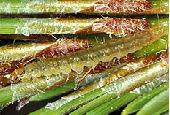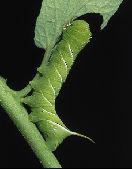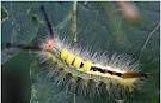Natural Solutions to Things That Bug You (35 page)
Read Natural Solutions to Things That Bug You Online
Authors: Myles Bader

LOOKING UP
The bug lays eggs in clusters on the underneath sides of leaves. You can spot them by the white spots on top of the leaves.
NAVAL ORANGEWORM
General Information:
 These caterpillars attack walnut, almond and pistachios and enter the nut after the hulls split, then feed on the nutmeats contaminating the nuts with their excrements. The caterpillar has a white to pinkish body with a reddish-brown head.
These caterpillars attack walnut, almond and pistachios and enter the nut after the hulls split, then feed on the nutmeats contaminating the nuts with their excrements. The caterpillar has a white to pinkish body with a reddish-brown head.
 It has a crescent-shaped mark on the second segment behind the head, which makes it easy to identify from a codling moth. They will weave their home around a nut making it into a
It has a crescent-shaped mark on the second segment behind the head, which makes it easy to identify from a codling moth. They will weave their home around a nut making it into a
“
mummy nut
.”
These nuts should be removed and destroyed.
WATCH FOR NUT-SPLIT
You need to harvest the nuts as soon as nut-split occurs so that the worm will not have a chance to set up housekeeping.
PARASITES ARE AVAILABLE
There are two parasites that are commercially available that will combat the naval orangeworm problem. They are
Copidosommopsis plethorica
and
Goniozus legneri
.
ORANGE TORTRIX CATERPILLAR
General Information:
 This is a brownish-colored caterpillar that has a larva that rolls up in a leaf with a web and will feed inside it. If you find that you have a number of oranges falling before their time it is probably due to this pest boring into the rinds.
This is a brownish-colored caterpillar that has a larva that rolls up in a leaf with a web and will feed inside it. If you find that you have a number of oranges falling before their time it is probably due to this pest boring into the rinds.
It will lay their eggs on the surface of the leaves or underneath the leaf looking like cream-colored discs. The eggs will destroy the leaves. If you see one of these caterpillars with white eggs on its back it would be best to leave it alone. The eggs are from a parasitic wasp and will be beneficial to your garden.
TWO GOOD KILLERS
There are two good methods of getting rid of these pests; either use Bt or dust or spray with pyrethrum.
EXOCHUS TO THE RESCUE
The parasite wasp species
Exochus
attacks the larvae of the orange tortrix caterpillar and has been found to be very effective. Other parasites that are also effective in control are
Apanteles aristolilae
and a tachinid fly called
Nemorilla pyste
.
POTATO TUBERWORM

It attacks tomatoes, potatoes, eggplant and peppers at their terminal end and burrow in killing the fruit or vegetable. They are somewhat pinkish with dark heads.
 Be sure and check potatoes before storing or they will kill most of the potatoes. If you have a problem with potatoes and this bug, be sure and do not plant tomatoes or eggplant near the field.
Be sure and check potatoes before storing or they will kill most of the potatoes. If you have a problem with potatoes and this bug, be sure and do not plant tomatoes or eggplant near the field.
SALTMARSH CATERPILLAR
General Information:
 These caterpillars attack beans, lettuce, tomatoes and love grapes. They will skeletonize leaves in short order and are not a very welcome visitor to your garden. They have very long hairs with orange, white and black tufts. They usually lay their eggs in a weedy area and then go to the garden for their meals. The best method of stopping them has been with a barrier of aluminum foil or Bt.
These caterpillars attack beans, lettuce, tomatoes and love grapes. They will skeletonize leaves in short order and are not a very welcome visitor to your garden. They have very long hairs with orange, white and black tufts. They usually lay their eggs in a weedy area and then go to the garden for their meals. The best method of stopping them has been with a barrier of aluminum foil or Bt.
TOMATO HORNWORM

General Information:
These are 4-inch long caterpillars that are green with white bars and feed on tomatoes, potatoes, sweet peppers and eggplants. They have a horn but do not sting. A similar horned worm called the tobacco hornworm prefers tobacco plants. Handpicking is one of the best methods of eradicating these bugs.
BUGS VS WORMS
There are a few bugs that will keep these worms in line; they are the lacewing, trichogramma and the ladybug. Spraying Bt on the leaves will also help as well as planting strong-smelling herbs.
A PLANT BARRIER
Planting herbs or flowers that they do not wish to be around is an excellent method of controlling these pests.
If you plant basil, borage or marigolds around your garden you will never have a problem with the tomato hornworm.
SPARYING WORKS
Using a hot pepper or limonoid spray will keep this pest from eating you plants. Either crush citrus fruit peels in water overnight or mix Tabasco Sauce™ and water to make the sprays and be sure to strain before using. Always test a few leaves and allow it to stand overnight to be sure that you do not have too strong a formula for that particular plant.
PREDATORS TO THE RESCUE
Predators that will eliminate these bugs include ladybugs, trichograma wasps and lacewings. Also if you plant some dill they will head right for it making it easier to catch them.
TOMATO PINWORM
General Information:
 These small caterpillars attack tomatoes and are usually found in coastal areas around Southern California and the San Joaquin Valley. They bore into the tomatoes at the stem end and make narrow blackened tunnels, which then expose the tomato to bacterial infestation and decay. The caterpillars are gray to a yellowish color with red or purple around each segment. If you are having a problem with this worm it is best not to grow tomatoes in the area for about 3 months and there should be no tomatoes grown within 4 miles of the area. Pheromone traps also work well.
These small caterpillars attack tomatoes and are usually found in coastal areas around Southern California and the San Joaquin Valley. They bore into the tomatoes at the stem end and make narrow blackened tunnels, which then expose the tomato to bacterial infestation and decay. The caterpillars are gray to a yellowish color with red or purple around each segment. If you are having a problem with this worm it is best not to grow tomatoes in the area for about 3 months and there should be no tomatoes grown within 4 miles of the area. Pheromone traps also work well.
WHITEMARKED TUSSOCK MOTH
General Information:

 This is a weird-looking caterpillar that has a red head from which will sprout two hornlike tufts of long black hair with another tuft appearing from the tail. It has a black and yellow stripe down its back.
This is a weird-looking caterpillar that has a red head from which will sprout two hornlike tufts of long black hair with another tuft appearing from the tail. It has a black and yellow stripe down its back.
